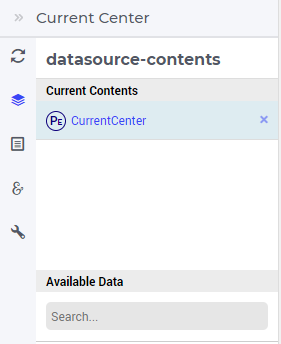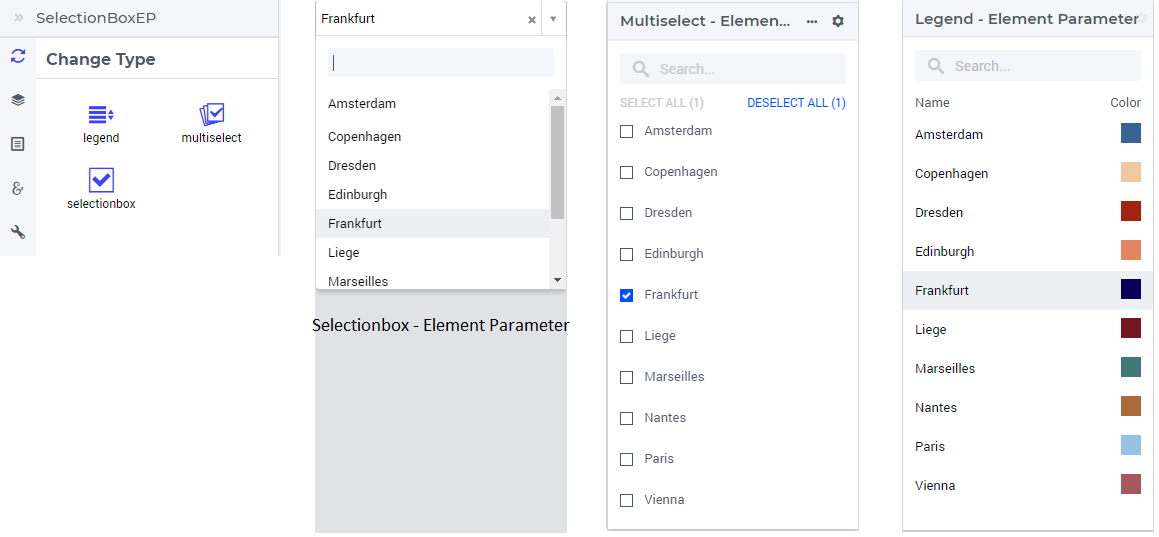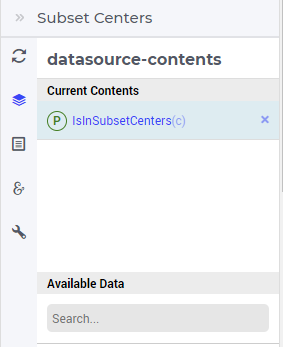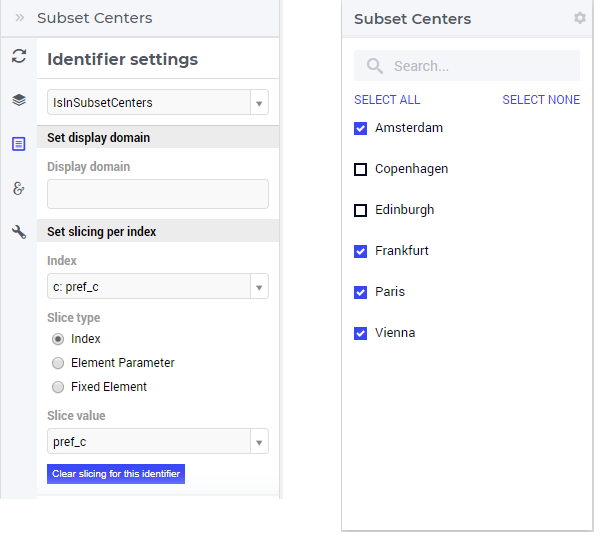Selection Widgets
Selection widgets allow the user to select one element in a set or a subset of elements in a set by using an element parameter or an 1-dimensional binary indicator parameter, respectively. The available types of selection widgets are selectionbox, multiselect, and legend (see further below).
Selection Widgets with Element Parameter
It is possible to specify an element parameter as data identifier in the Contents tab of the widget’s options editor, where one may search for the available model data using the corresponding functionality at the bottom:

In our example (see the “Quick Start: My First WebUI” section), CurrentCenter is declared as an element parameter with the range the set Centers. The value of this element parameter may be viewed using a selectionbox, a multiselect, or a legend type, according to the choice made in the Change Type tab

Selection Widgets with an 1-dimensional Binary Parameter
It is also possible to specify a 1-dimensional binary parameter as data identifier in the Contents tab of the widget’s options editor, where one may search for the available model data using the corresponding functionality at the bottom:

In our example, the binary parameter IsInSubsetCenters(c) is declared with the index domain the set Centers. In this case, it is appropriate to use a multiselect type of widget which allows to select several elements from the underlying set:

Note that, in this case it is still possible to switch to other representation type, e.g.. to selectionbox, but then the selection is restricted to just one element from the underlying set.
Note
In the AIMMS 4.97.1 release, we enhanced the functionality of the Select and Deselect links in the MultiSelect widget. With this improvement, when you apply a filter to the widget, the “Select” and “Deselect” links will now accurately select or deselect all the filtered entries. Furthermore, for added clarity, we’ve included a count of available entries next to the “Select” and “Deselect” links.
Note
Identifier Settings
In the Identifier Settings tab of the widget’s options editor, one can apply a display domain in the “Set display domain” section, which works in the same way as for other widgets.
In the case of a selection widget with an 1-dimensional binary parameter, in the “Set slicing per index” section it is possible to slice the underlying index to another index of a subset. For instance, we can slice our center index c to the index pref_c of a subset PreferredCenters of the root set Centers. Assuming that the subset PreferredCenters set has the elements {Amsterdam, Copenhagen, Edinburgh, Frankfurt, Paris, Vienna}, this results in a possible multiselection view for IsInSubsetCenters(c) as shown here:

So, in such a case the multiselect widget may modify only those values of IsInSubsetCenters which correspond to some center which belongs to the PreferredCenters (sub)set.
Miscellaneous options
In the Miscellaneous tab of the widget’s options editor, other options may be set such as the title of the widget and whether or not the widget is visible (this may be determined by a constant or by a parameter from the model).
Warnings and trouble shooting
Warning
The current implementation of all Selection widgets (selectionbox, multiselect, and legend) fetches the entire input set from AIMMS, and then applies the filtering in the browser.
Please keep in mind that if you have a very large set, slow computer or high latency & low bandwidth network, the selection widget might end up in an “Empty” state, because the browser hits the time limit while fetching the data. For example, a selectionbox will look as shown below.

If you are in this situation:
Please try to work with several subsets, or try to use another widget.
The table widget for example is our most advanced widget. It can be used to make a selection, together with a custom scalar string search updating the table widget’s display domain.
Note
In the 4.70.2 release of AIMMS, we increased the timeout from 15s to 25s.